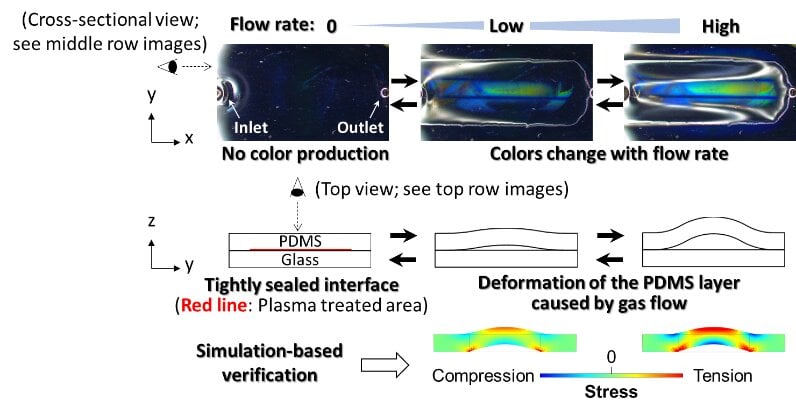Researchers from the National Institute for Materials Science (NIMS, Japan), Harvard University, and the University of Connecticut jointly designed and fabricated a device for imaging a gas injected into it, in multiple colors and in accordance with its gaseous properties, enabling chromatic discrimination of different gases. The device converts the pressure generated by an injected gas into structural color, thereby “imaging” it.
The technology holds potential for a range of applications, including environmental monitoring, safety assurance, and health care.
Almost all ambient gases are colorless and invisible, and only a few methods for imaging ambient gas flow have been developed. These include the use of infrared cameras capable of detecting temperature changes and airflow measurements by means of releasing tracer particles into the air. These methods require elaborate equipment and are unsuitable for imaging different types of gases in a consistent manner. In addition, the images they produce are unfit for the analysis of gaseous characteristics.

Mechanism behind the multicolor imaging of a gas injected into the device. Top (top row) and cross-sectional (middle and bottom rows) views of the device and a gas flowing through it. Courtesy of Kota Shiba/National Institute for Materials Science.
To develop the device, the researchers shaped a soft material called polydimethylsiloxane (PDMS) into a slab, and treated part of the slab’s surface with argon plasma. The plasma-treated slab was then placed on the surface of a glass substrate with the plasma-treated surface facing down to establish complete contact. The plasma-treated PDMS surface formed a periodic ripple-like micropattern when compressed by an injected gas passing through the tight boundary between the PDMS and glass layers. This compression and resultant micropattern formation lead to the production of structural colors.
When the incoming gas flow was discontinued, the structural colors disappeared completely.
The researchers used this simple setup to measure arbitrary gases. The device analyzed their flow rates, densities, and viscosities based on the change in color.
"This device does not even have a channel, instead, gas can flow between the PDMS and the glass by deforming the PDMS wall, in other words, by making an interstice as a temporary path for the flow," the researchers said, in their paper.
"The formation of the temporary path results in a compressive bending stress at the inner wall of the path, which leads to the formation of well-ordered wrinkles, and hence, the emergence of structural color that changes the optical transmittance of the device," they said.
According to the researchers, this mechanism is applicable to the imaging and differentiation of any type of gas. The degree of PDMS deformation depends on the flow rates, viscosities, and densities of injected gases. As all gases have unique viscosities and densities, the device could be used to differentiate and analyze gas samples based on these properties under a constant flow rate.
In future research, the team will optimize the device by improving its sensitivity with the goal of making it compatible with various applications — for example, the identification of ambient gases and biological samples. Also, the team will consider developing a new gas identification technique by combining it with image recognition and machine learning techniques and fabricating a small, CCD-integrated device with a simple structure.
The research was published in Advanced Science (www.doi.org/10.1002/advs.202204310).